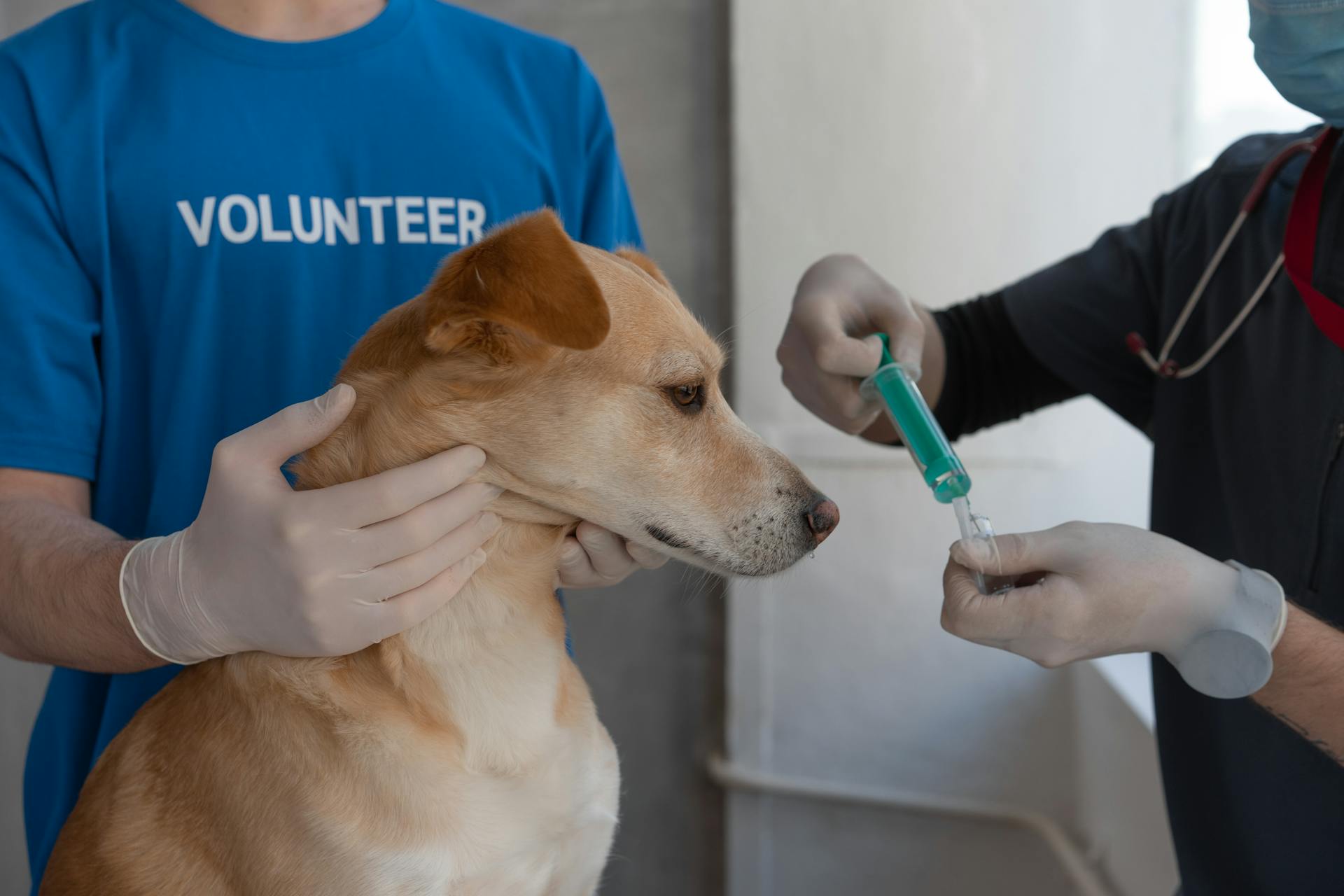
Some flea collars can indeed make a dog sick, and it's essential to understand the risks involved.
Flea collars contain toxic chemicals like tetrachlorvinphos, which can cause vomiting, diarrhea, and even seizures in dogs.
These chemicals can also lead to more severe health issues, such as liver damage and respiratory problems.
According to studies, dogs that wear flea collars for extended periods are at a higher risk of developing these health issues.
Flea collar toxicity can also occur if a dog ingests the collar or breaks a piece off, which can lead to serious health complications.
Symptoms of flea collar toxicity can appear within hours of exposure and may include lethargy, loss of appetite, and difficulty breathing.
Explore further: Health Hazards of Dog Urine and Feces
Symptoms and Effects
If your dog is experiencing symptoms after wearing a flea collar, it's essential to know what to look out for. Scratching and intense itchiness can develop within minutes to hours after application.
Some dogs may exhibit restlessness, while others may roll around on their back or try to bite the affected area. You may also notice vocalization, crying, or whimpering.
Redness, hair loss, and scarring can occur at the site of application. In severe cases, dogs may drool, vomit, or experience a lack of appetite.
Here are some possible symptoms in a list format:
- Scratching/intense itchiness
- Restlessness
- Rolling around on the back or trying to bite the back
- Vocalization, crying, whimpering
- Redness, hair loss and future scarring and site of application
- Drooling
- Vomiting
- Lack of appetite
- Gagging or hacking
- Agitation
- Muscle tremors
- Difficulty standing or walking
- Weakness
- Seizures
- Death
If you suspect your dog is experiencing toxic side effects, it's crucial to seek emergency vet care immediately.
Causes and Diagnosis
A flea collar can make a dog sick if it contains a pyrethrin or pyrethroid, which are common active ingredients in many flea and tick medicines.
Your veterinarian will make a presumptive diagnosis if there's a known or possible history of exposure to a product containing these ingredients.
A complete physical examination is the first step in diagnosing flea collar poisoning in dogs.
Causes
Unintentional poisoning in dogs often occurs through the misuse of flea and tick prevention. This can happen when the wrong product is given to a dog.
Dogs may become poisoned if the correct drug, dose, and size of the product are not verified before medicating. The proper time frame between doses must also be respected.

Giving expired medications to dogs is a common mistake that can lead to poisoning. Cutting larger sizes into smaller pieces or giving multiple smaller doses can also cause harm.
If a product is labeled for cats, it should not be given to a dog, and vice versa. This is because different species have different sensitivities to certain chemicals.
Not all flea and tick products contain toxic ingredients, but varying concentrations of drugs can still cause symptoms. If you notice any adverse effects, consult your veterinarian immediately.
Recommended read: Dog Flea Treatment Not Working
Veterinarians Diagnose
A veterinarian will make a presumptive diagnosis if there is a known or possible history of exposure to a product containing a pyrethrin or pyrethroid, or ingestion of flea/tick medicine.
Blood work and urine testing may help rule out other possible causes.
In a presumptive diagnosis, a veterinarian has a good reason to believe that something is causing the problem but can't prove it with a specific diagnostic test.
Pruritus, or itchy skin, is the most reported adverse effect for dogs, affecting 54% of the incident cases reviewed by the EPA.
Lethargy and anorexia are also common adverse effects, each reported in approximately 10% of cases.
Veterinarians will consider concurrent medical conditions when diagnosing flea and tick medicine poisoning in dogs.
Treatment and Recovery
Treatment of flea and tick medicine poisoning in dogs can be done on an outpatient basis or in a hospital setting, depending on the severity of the toxicity and the symptoms displayed.
If your dog ingests a toxic substance, it's essential to act quickly to minimize the damage. You can start by bathing your dog with a liquid dish soap like Dawn, Joy, or Palmolive to remove the greasy substance.
The prognosis for recovery is good if treated promptly, but if your dog develops neurologic signs, kidney issues, seizures, and elevated body temperature, the prognosis is generally poor.
In cases of poisoning, supportive care might be necessary, which can include repeat bathing, intravenous fluids, anti-nausea medications, muscle relaxation, and seizure medication.
Here's a breakdown of the supportive care your dog might need:
- Repeat bathing
- Intravenous (IV) fluids
- Anti-nausea medications
- Muscle relaxation
- Seizure medication
Your veterinarian might also want to monitor your dog's temperature, blood sugar levels, and kidney function, as these can be affected by toxicity in dogs.
Treatment
Treatment is a crucial step in helping your dog recover from flea and tick medicine poisoning.
The first thing to do is to get the greasy substance off your dog's fur and out of their mouth. This can be done by bathing your dog with a liquid dish soap like Dawn, Joy, or Palmolive.
You'll also need to rinse your dog's mouth with copious amounts of water, and if necessary, use a garden hose to help flush out any toxins that were ingested.
In cases where your dog is showing neurologic signs, it's best to have them hospitalized for several days to minimize the extent and severity of these symptoms.
Your veterinarian may also recommend supportive care, which can include repeat bathing, intravenous fluids, anti-nausea medications, muscle relaxation, and seizure medication.
Recovery and Management

Prompt recognition and early treatment can greatly improve your dog's chances of a good outcome.
If your dog develops severe symptoms such as neurologic signs, kidney issues, seizures, and elevated body temperature, the prognosis is generally poor.
Most mild symptoms like excessive drooling, paw flicking/scratching, and ear twitching are often temporary and can go away on their own.
Drooling may persist for several days after using a flea-control product, but most symptoms resolve within a few days.
With proper care and attention, most dogs can recover from flea and tick medicine poisoning within a short period of time.
A unique perspective: What Does Flea Infestation Look like on a Dog
Prevention and Alternatives
To prevent flea and tick medicine poisoning in dogs, it's essential to follow all directions carefully and ensure your dog only receives his prescribed medication as flea and tick preventatives are dosed on body weight.
Always speak to your veterinarian about the risk of drug interactions, especially if your dog is taking multiple medications.
To avoid accidental overdose, never use part of a larger-sized dose or multiple smaller doses, as this may result in an overdose and increased chance of poisoning.
Some natural methods to consider include using apple cider vinegar, which can be added to your dog's water or food, or used as a homemade flea repellent by mixing 1 part water to 1 part apple cider vinegar.
Other alternatives include diatomaceous earth, which can be spread around the home to minimize and prevent fleas, but should never be applied directly to your pets as they may experience severe skin irritation.
Here are some safe essential oils that can be used to control and prevent fleas: CedarCedarwoodCloveLavenderLemongrassRosemaryRose geraniumPeppermint Always discuss your decision with a veterinarian before treating your pet for fleas.
Prevention
Prevention is key when it comes to avoiding flea and tick medicine poisoning in dogs. Always follow the directions on flea and tick preventives carefully.

To prevent accidental exposure, ensure your dog only receives his prescribed medication. This is because flea and tick preventatives are dosed on body weight, so giving the wrong dose can lead to poisoning.
Don't give your dog more than one drug at a time, as this can cause an accidental overdose and interact with other medications. Speaking to your veterinarian about the risk of drug interactions is always a good idea.
Don't use part of a larger-sized dose or multiple smaller doses, as this may result in an overdose and increased chance of poisoning.
Curious to learn more? Check out: Dog Flea Treatment Overdose Symptoms
Safe Alternatives
If you're looking for safe alternatives to traditional flea collars, there are several options to consider. Apple cider vinegar is an excellent flea preventative, though it won't help if your pet already has fleas.
You can bathe your pet with it, add it to their water or food, or make some homemade flea repellent by mixing 1 part water to 1 part apple cider vinegar. This natural method can be a great addition to your flea-fighting arsenal.
Broaden your view: Dog Flea Bath Vinegar

Diatomaceous earth is another natural solution that works to minimize and prevent fleas from entering your home. However, be careful not to apply it directly to your pets, as it can cause severe skin irritation.
If you're interested in using essential oils, there are several options to choose from. Oils like cedar, cedarwood, clove, lavender, lemongrass, rosemary, rose geranium, and peppermint are frequently used to control and prevent fleas.
Remember to always dilute these oils and consult with your veterinarian before using them on your pet. This will ensure their safety and effectiveness.
Here are some natural methods to consider:
- Apple cider vinegar: bathe your pet with it, add it to their water or food, or make a homemade flea repellent by mixing 1 part water to 1 part apple cider vinegar.
- Diatomaceous earth: spread it around your home to prevent fleas from entering, but avoid applying it directly to your pets.
- Essential oils: use oils like cedar, cedarwood, clove, lavender, lemongrass, rosemary, rose geranium, and peppermint, but always dilute them and consult with your veterinarian.
Sources
- https://www.petmd.com/dog/poisons/flea-and-tick-medicine-poisoning-in-dogs
- https://www.usatoday.com/story/news/investigations/2023/07/14/epa-leaves-seresto-flea-collar-on-market-after-studying-pet-effects/70414721007/
- https://cedarcide.com/blogs/guides/need-stop-using-flea-collars-today
- https://www.petinsurancereview.com/blog/hidden-dangers-flea-collars
- https://www.dogsnaturallymagazine.com/seresto-collars-for-dogs-are-they-safe/
Featured Images: pexels.com


